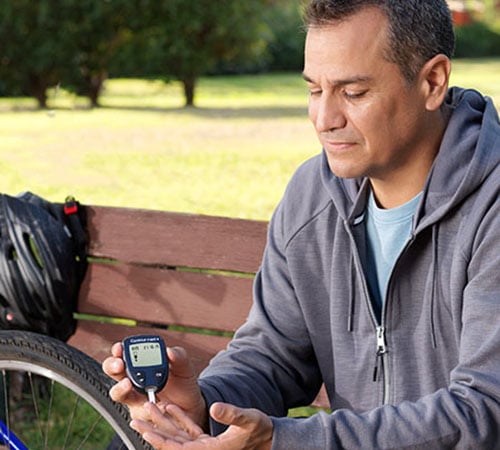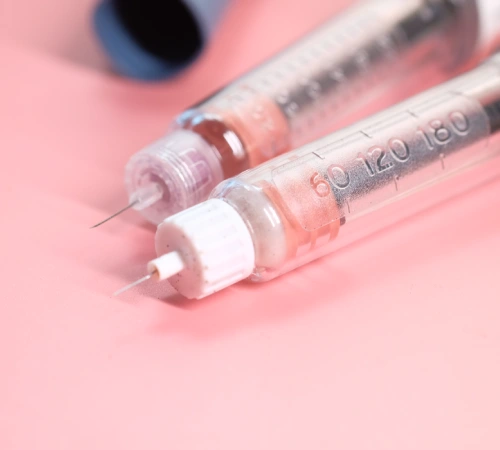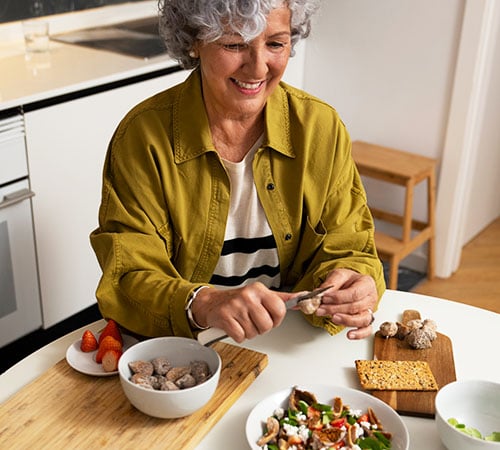Did you know?
Scientifically proven, CONTOUR®PLUS BLUE has accuracy that exceeds the required industry standard~†1,2, ensuring better glycaemic control.
Accuracy is important when:Diabetes is a condition where the amount of sugar (glucose) in your blood is higher than normal. Type 1 diabetes is where the body produces little or no insulin. Insulin is needed to help sugar enter the cells of your body. The sugar comes from the food you eat and it is used in all cells and organs to generate the energy that keeps your body going.
The insulin that is missing in your body has to be replaced. Usually, insulin has to be injected into the subcutaneous tissue (belly or thigh).
People with type 2 diabetes are still able to produce insulin, but the cells are unable to respond to the insulin properly. Most people with type 2 diabetes need pills and/or insulin injections to regulate the amount of sugar in their blood (also called blood sugar levels).
Food intake, delivering sugar to the cells and turning it into energy are essential processes in our bodies. The levels of sugar in the blood result from these processes. If the levels are too high or too low, there is the risk of serious consequences for your body. Therefore, normal blood sugar levels are important for your health.
Your blood sugar level can be measured using a “blood glucose meter” or “blood glucose monitor”. You simply take a drop of blood by finger prick and the meter tells you how much sugar is in your blood at that time. This way, you can check if your blood sugar level is in the healthy range.

When the sugar level in your blood rises above the normal range, you become hyperglycaemic. If your sugar level stays too high for a long time, there is a risk of damage to organs and other complications.
High blood sugar levels develop when your body does not produce enough insulin. It can also happen when a person with diabetes forgets an insulin injection or if the injected insulin dose was too low.
Your blood sugar level can also fall below the normal range, resulting in hypoglycaemia. Hypoglycaemia is often called an “insulin reaction”, because it can occur after taking too much insulin. Low blood sugar levels are common with type 1 diabetes patients – on average, episodes with symptoms occur twice a week. The number of unnoticed lows (without symptoms, at night) could be even higher.
If blood sugar levels fall too low, you can lose important functions, such as the ability to think and act normally. Low blood sugar levels require immediate action!
Contact your Healthcare Professional to discuss your individual blood sugar target range.
Insulin is a hormone that is naturally produced by the pancreas. Without insulin, sugar cannot enter the cells and piles up in the blood. Insulin is the medication for people whose pancreas does not produce enough insulin (type 1 diabetes) or whose cells do not respond to insulin properly (type 2 diabetes).

When blood sugar levels rise after a meal, insulin is needed for people with type 1 diabetes to bring the sugar levels back to normal. In healthy people, the pancreas provides the right amount of insulin. People with type 1 diabetes have to inject insulin several times daily with insulin pens, syringes, or insulin pumps. Blood sugar monitoring helps you to determine when and how much insulin you need to inject.
There are several types of insulin, based on how fast and how long they act in the human body. Your Healthcare Professional will work with you to select the one that is best for you.

| Type of insulin | Delivery (time taken to reach bloodstream*) | Peak (time taken to reach highest level of effectiveness*) | Duration (length of time it stays effective) |
|---|---|---|---|
| Rapid-acting | ≈15 minutes | ≈1 hour | ≈2 to 4 hours |
| Regular or short-acting | ≈30 minutes | ≈2 to 3 hours | ≈3 to 6 hours |
| Intermediate-acting | ≈2 to 4 hours | ≈4 to 12 hours | ≈12 to 18 hours |
| Long-acting | Several hours | Reduces blood sugar levels relatively steadily over 24 hours |
* time after injection
The food you eat has a large influence on the sugar levels in your blood. It is important to know your foods and to manage your insulin injections accordingly. A dietitian who has expertise in type 1 diabetes can help you set up a plan for a balanced diet, your insulin doses and the right level of activities. When your eating habits or preferences change, it is time to update your eating plan!
When you move, your body consumes more energy and uses up the sugar faster than when you rest. Being active is good! In the long run, exercise will help to stabilize your blood sugar levels.
Social and emotional support can positively boost your well-being. It can be very helpful to share your experiences with other people with diabetes. A good network of support from family members, friends, and diabetes patients organisations really makes a difference!
Insulin may need to be refrigerated. If the injection of cold insulin is painful for you, the insulin can be held at room temperature before injection. Some insulin products can be stored in this way for about one month. Please make sure to always check and follow the supplier’s instructions.

It's not always easy to perform a blood glucose reading. The CONTOUR®PLUS BLUE blood glucose meter provides you with 30 seconds to apply more blood to the same strip8, if needed, making easy to perform a reading even in imperfect conditions.
For more information and personalised advice about type 1 diabetes, please contact your Healthcare Professional.
Sources: www.diabetes.org
~Minimum accuracy requirements of ISO15197: 2013 Section 8 standard require ≥95% of the measured values to fall within ±0.83 mmol/L at glucose concentrations <5.5 mmol/L and within ±15% ≥5.5 mmol/L of the referenced method.
†An ad hoc analysis demonstrated that 95% of the results were within the error range ±0.48 mmol/L or ±8.7% of the laboratory reference values for glucose concentrations <5.5 mmol/L or ≥5.5 mmol/L, respectively.